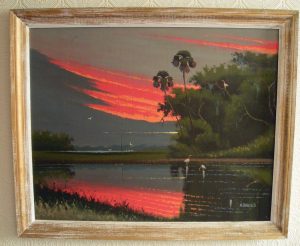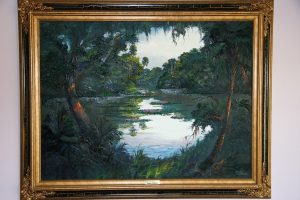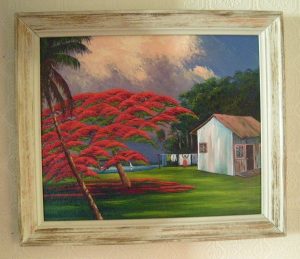Isabelle Geiger
Isabelle Geiger
Serene Florida: Captured by the Florida Highwaymen
Preface:
Hi, My name is Isabelle Geiger and this portfolio is named “Serene Florida: Captured by the Florida Highwaymen.” The licensing I will be using is CC BY 4.0.
Introduction:
The main focus of this portfolio is to acknowledge the way in which Florida was illustrated on nearly 200,000 canvases to be beautiful, still, timeless, and untouched, despite the outstanding adversity and injustice that defined this time period for black citizens in the south. The Florida Highwaymen are a group of twenty-six African American artists that depicted the vibrance and richness of Florida’s landscapes while facing the harsh terms of Jim Crow Laws during the 1950s. The works of the Highwaymen, although arguable pristine, were unable to be represented in white-only galleries. Their misrepresentation and lack of appreciation as a result of the era created their untraditional style of using an “assembly line” of quick stroke painters, in which dozens of unique and detailed pieces of similar Florida landscapes were painted each day in order to make a way of living. The environmental art brought beauty and appreciation for the unmatched serenity of Florida’s landscapes, masking the bigotry that occupied the same terrain.
Themes:
There are two main themes that I will be exploring in this portfolio. The first theme focuses on nature as a home to all. Although black and white citizens lived polar lives during the 1950s, the beauty of Florida would be appreciated and valued by those of different backgrounds and social or socioeconomic status. Society in the 1950s could have been described as stifling. However, seeing one’s environment taken into forms of hypnotic art with rich colors that embed pure simplicity could have been, understandably, relieving and a reminder of nature as a home to all. The second theme I will outline describes environmental art as a way to face oppression. The highwaymen’s response to the lack of opportunity to make a profit was to try to make a way out of no way by creating their own artistic style and by enterprising in an unheard-of fashion. The creative selling of environmental art can thus be seen as a symbol for the counterattack against persecution.
Analysis:
The three images that I chose all exhibit the resilience and resourcefulness of the symbolic Florida Highwaymen.

In this painting, Willie Daniels perfectly conveys a signature Florida sunset hovering over the flat and swampy biome, in which inhabit the Sabal Palms and Ibis birds. The rushed work environment of the Highwaymen combined with the need for financial gain forced much of their work to be created through memory on untraditional, but inexpensive mediums including roofing material and masonite, thus adding yet another layer of talent. Ambiguously, the Florida ambience was accurately conveyed in fine detail as a thoughtful way to invite people into the unfair conditions of an African-American man during the 1950s.
The lack of conformity to artistic norms is interpreted to be a powerful way to fight against racist expectations of non-white citizens by exhibiting resourcefulness during a time that can be described as one with a lack of opportunity. While selling art pieces for a mere twenty-five dollars, the hurried painter fought the norms and expectations of black men to perform manual labor during the period of intense oppression. Willie Daniels paintings, with their classic nail-etched “W. Daniels” signature, illustrate images of an evolving scene of harmony within the world of art, bringing appreciation for the environment to both those that have dealt with injustice, and those who have not.

The creator of this painting, James Gibson, was noted to be one of the most successful and active self-taught artists of the Highwaymen. His personal maxim elucidates his approach on life: “respect people, don’t give up, and put God first. Everything else,” he said, “will fall into place.” By following this formula of optimism while painting up to one hundred paintings through the night, most nights, and selling the paintings in the trunk of his tattered Cadillac, he could make enough money for gas. Despite the obvious disadvantages presented by the time period, the Highwaymen often had the best luck, with sales in white neighborhoods by utilizing the respectful method of Gibson. Although this perceived good luck was usually only a ten-percent success rate, the Highwaymen continued to challenge the racist standards created by white citizens by literally, confronting them at their front door with environmental art. Once again, environmental art can symbolize how those of dissimilar backgrounds can appreciate nature’s beauty in order to coincide.

The foreground of this painting exhibits the natural beauty of Florida’s native vegetation, greenery, rural architecture, and magical sky. Apart from this, the background features a black woman taking care of the laundry of those that live in the quaint, white home. The beauty of the landscape and thoughtful usage of hues and tones put into the sky, swaying trees, and welcoming home make the blurred woman seen in the distance seem almost insignificant.
Mary Ann Carol was the only female member of the Florida Highwaymen, and she began painting as an escape from the life she lived in poverty. Different from the majority of the Highwaymen, she was forced to work in tomato fields in between her shifts of painting and selling in order to support herself and her seven children. The painting shown above can be interpreted to symbolize women such as Mary Carol Ann who are determined to fight oppression while also being constricted by the need to make an income. The lack of attention drawn to the woman in the painting only highlights the way in which the lack of accessible employment was unnoticed to those that were not influenced by Jim Crow laws directly. Today, the image can be interpreted in this way by reflecting on American history, however, the Florida Highwaymen and those that purchased their environmental art may have simply had an admiration for the tranquility of a Florida sunset.
Application:
Environmental art is somewhat unnoticed when considering the civil rights movement and the fight for change. Undeniably influential in this fight, art created by the Florida Highwaymen introduced a new perspective on the lack of opportunity for African American citizens in the south. By making a way out of no way, the Highwaymen went against tradition in order to succeed. Their success could be defined by either their financial gain or the slight unification of black and white art enthusiasts. Either way, their success was stemmed from the celebration of nature and the creation of environmental art. All of the art created by the Florida Highwaymen provides an open interpretation on how deeply certain aspects of the time period influenced the artwork directly. However, it is clear that the environmental art is both noteworthy and applicable in understanding the disadvantages of non-white citizens and the society of non-white citizens in the 1950s. The unconventional methods of the Florida Highwaymen present an unconditional way to understand the struggles of the Florida Highwaymen and the people they proudly represent.

